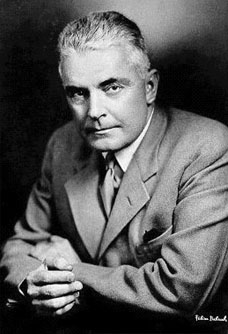
Associated with many different topics, John Broadus Watson (1878 - 1958) is most widely known as an American psychologist. He finished high school and got his masters degree at an early age, perhaps sparking his interest for children and child-rearing. The immediate connection to his name, however, is "Little Albert".
The "Little Albert" experiment was conducted in 1920 by Watson and his assistant, Rosalie Rayner. It was performed to test classical conditioning [see related article http://nanniesplaceboeffect.blogspot.com/2010/03/pavlov-psychology-reaches-for-nobel.html] in humans. The experiment was carried out shortly after classical condition had been "discovered", and seven years before the original experiments on the subject had first been published in English. This meant that they had minimal knowledge on the subject and, since it was conducted before stricter regulations had been passed, not properly controlled.
The study was set in a room at John Hopkins University, experimenting on and off for approximately two and a half months. "Little Albert's" first introduction to the experiment was at nine months of age, when he was first briefly exposed to several different animals (rabbits, rats, monkeys) and objects, showing no fear towards anything. Two months later, he was again faced with a white rat, still without any trace of anxiety or fear. From the next session and onward, Watson or his assistant produced a loud metallic noise every time "Little Albert" touched the rat. With time, he learned to associate the loud noise to the rat, causing a strong fear between him and the rodent. When the experiment finally ended, "Little Albert" had developed a fear for furry objects in general, including a furry dog, Santa Claus mask, and, of course, rats.
Today, many people find Watson's experiment highly controversial and unacceptable. Yet, at Watson's time, he barely received any critique for this experiment at all. Instead, he was slandered for his treatment of rats during his study "Kinaesthetic and Organic Sensations: Their Role in the Reactions of the White Rat to the Maze" - something which today is almost entirely forgotten.
For further reading about John B. Watson and his "Little Albert" experiment, please visit http://psychology.about.com/od/profilesofmajorthinkers/p/watson.htm
The "Little Albert" experiment was conducted in 1920 by Watson and his assistant, Rosalie Rayner. It was performed to test classical conditioning [see related article http://nanniesplaceboeffect.blogspot.com/2010/03/pavlov-psychology-reaches-for-nobel.html] in humans. The experiment was carried out shortly after classical condition had been "discovered", and seven years before the original experiments on the subject had first been published in English. This meant that they had minimal knowledge on the subject and, since it was conducted before stricter regulations had been passed, not properly controlled.
The study was set in a room at John Hopkins University, experimenting on and off for approximately two and a half months. "Little Albert's" first introduction to the experiment was at nine months of age, when he was first briefly exposed to several different animals (rabbits, rats, monkeys) and objects, showing no fear towards anything. Two months later, he was again faced with a white rat, still without any trace of anxiety or fear. From the next session and onward, Watson or his assistant produced a loud metallic noise every time "Little Albert" touched the rat. With time, he learned to associate the loud noise to the rat, causing a strong fear between him and the rodent. When the experiment finally ended, "Little Albert" had developed a fear for furry objects in general, including a furry dog, Santa Claus mask, and, of course, rats.
Today, many people find Watson's experiment highly controversial and unacceptable. Yet, at Watson's time, he barely received any critique for this experiment at all. Instead, he was slandered for his treatment of rats during his study "Kinaesthetic and Organic Sensations: Their Role in the Reactions of the White Rat to the Maze" - something which today is almost entirely forgotten.
For further reading about John B. Watson and his "Little Albert" experiment, please visit http://psychology.about.com/od/profilesofmajorthinkers/p/watson.htm







No hay comentarios:
Publicar un comentario